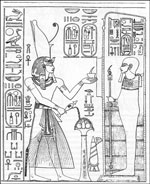
Polytheism,
henotheism, and monotheism
Throughout their history the Egyptians worshipped a great number
of gods. Tomb and literary texts indicate that an individual did
not ally himself with a single god. For example, the opening formula
of Late Ramesside letters recounts: "I call upon Amun Re, King
of the gods, Mut, Khonsu and all the gods of Thebes to bring you
back safe."
The religion of Akhenaten during the Amarna Period (Dynasty 18) has been
described as "monotheism," and heralded as a possible indication
that the Egyptians were the source of Judeo-Christian thought. Indeed, in
the Amarna Period, Akhenaten elevated his god, the Aten, to a supreme place
in the pantheon, and later in his reign his agents traveled through Egypt
physically expunging the name of other gods from monuments. The interpretation
of the religion of the Amarna age as true monotheism, however, cannot be
sustained in light of the simultaneous worship of other gods. Maat, both
as a concept and in her personification of a goddess, continued to be venerated,
and indeed the ritual of the presentation of her image reached new prominence
in the Amarna age. So too, in some circumstances, the king and queen were
associated with the gods Shu and Tefnut, respectively. Statuettes of Bes
and other members of the traditional pantheon have been recovered from houses
at Amarna. The greatest objection to the religion of the Amarna age being
true monotheism is the elevation of the king and his queen Nefertiti (and
perhaps, posthumously, Akhenaten's father, Amunhotep III) to divine status.
The vestiges of the old gods, as well as the triad formed by Akhenaten,
Nefertiti, and the incarnation of the solar light as the Aten, consisted
of yet another conventional grouping of gods, not the formation of a transcendent
monotheistic godhead.
The religion expressed in the Amarna age is better termed henotheism, the
temporary elevation of one god above others. This trend to henotheism continued
in the Ramesside Period, with the elevation of various forms of Amun to
the supreme god, but without the intolerance for other gods seen in the
late Amarna Period. Some theologians even argue for the presence of a transcendent
god into whom all other gods were subsumed during the Ramesside Period.
«
previous
6 of 6
|
 |

|
 |


Figure
5: Ramesses III performs the Sed festival. »
| E
X P L O R E |
| The
Further Exploration page has many links to great
sites about Ancient
Egypt. |
|
|
|